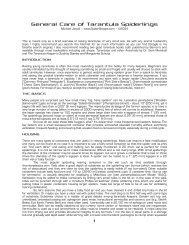KING BABOON TARANTULA
KING BABOON TARANTULA
KING BABOON TARANTULA
Create successful ePaper yourself
Turn your PDF publications into a flip-book with our unique Google optimized e-Paper software.
<strong>KING</strong> <strong>BABOON</strong> <strong>TARANTULA</strong>GLA<strong>KING</strong>CONCISE & PRECISE CARE SHEETOVERVIEWThe King Baboon Tarantula is now correctly known as Pelinobius muticus, but its scientific name was Citharischiuscrawshayi for a long time and may be more familiar. The term “baboon spider” is used to refer to all African tarantulascollectively, and is due to the resemblance of their legs seen protruding at the mouth of their burrows have to thefingers of baboons. The King Baboon is native to East Africa and is one of the largest of the African tarantulas. Itreaches a leg span approaching eight inches. Even more impressive than its size is the rasping threat sound it makes bystridulation; it rubs a rough surface on its chelicera against a similar opposing surface on its pedipalp to produce rhisfairly loud “hiss” to deter aggressors. It is an irritable species that can deliver a painful bite.ENVIRONMENTConditions » Day Temp 72-78°F Night Temp 70-75°F Humidity 50-65%Heat Source »Usually unnecessary. House enclosure in a warm area that provides appropriate temperature rangeand minimal drafts, light and vibration. If necessary, terrariums may be heated using a mini heat matmounted beneath or a very low wattage red (or “nocturnal”) bulb safely suspended above. Smallcontainers housing “spiderlings” are best heated by keeping inside a larger heated enclosure thatacts as an incubator.HOUSINGA terrestrial cage with plenty of ventilation (a plastic critter keeper style terrariumis excellent), slightly moist and very deep substrate (commercial organic soil mixesare excellent, but coconut coir or 50/50 sphagnum peat moss/vermiculite mix arejust as good), hiding place and small water dish — extra care should be used whenraising spiderlings as small containers typically used, such as vials or small jars withlids with small air holes, are too poorly ventilated (we use 16 oz. deli cups withinsect cup style lids to raise most young tarantulas). However, young tarantulas dorequire higher humidity than adults.King Baboons are best housed in a great depth of firmly packed substrate so thatthey can burrow. The use of a fairly narrow and tall container is popular as it oftenallow the spider to be observed even when it is deep in its retreat.DIETcrickets, grasshoppers, roaches, superworms; large specimens will eat adult roachesand young rodents, etc.KEEPER SAFETYOld World tarantulas do not have the urticating hairs most New World species brush from their abdomens in defensewhen disturbed. Instead, most species are quick to defend themselves by rearing up on their hind legs in readiness todeliver a very painful bite. Tarantulas are fragile creatures and we do not advocate handling.COMMENTSFor more information on general tarantula care see: http://www.tarantulas.com/care_info.htmlFor information on raising spiderlings and juvenile tarantulas see: http://www.tarantulas.com/spiderlings.htmlAlso see Michael Jacobi’s Tarantulas (Animal Planet Pet Care Library)This accurate care sheet is open source. The author encourages you to copy & share in the interest of the wellness of the critters.Written 2012 by Michael Andreas Jacobi. A PDF of this Concise & Precise Care Sheet may be downloaded at ExoticFauna.com.
<strong>KING</strong> <strong>BABOON</strong> <strong>TARANTULA</strong>GLA<strong>KING</strong>CONCISE & PRECISE CARE SHEETThis accurate care sheet is open source. The author encourages you to copy & share in the interest of the wellness of the critters.Written 2012 by Michael Andreas Jacobi. A PDF of this Concise & Precise Care Sheet may be downloaded at ExoticFauna.com.



